Indra Jatra, often called Yenyā Punhi, is the most lively and vibrant street festival celebrated in Kathmandu, deeply embedded in the rich traditions of the Newar community. In 2025, this magnificent festival is set to begin on Saturday, September 6, coinciding with the 15th day of Yanlā, which is the 11th month of the Nepalese lunar calendar.
Kathmandu's complete moon celebration is the literal translation of Yenyā Punhi, which honors King Gunakamadeva's 10th-century city founding. Lord Indra, the Hindu god of rain, is celebrated during the eight-day Indra Jatra festival. It combines Hindu and Buddhist traditions to reflect Kathmandu's rich spiritual heritage.
The celebrations officially begin at Kathmandu Durbar Square with the ceremonial raising of the Yosin pole. During the festival, participants have the chance to engage in many activities, including lively masked dances that depict a variety of deities and demons, sacred exhibitions, and the grand chariot procession featuring the living goddess Kumari. The worshipped gods Ganesh and Bhairav accompany the residing goddess Kumari in this colorful procession. Indra Jatra is a powerful manifestation of religious faith that honors Kathmandu's rich cultural legacy, emphasizing its unique customs and the close ties that bind its citizens. Hindu families, especially those in the Nepalese Newari community, use this festival as an essential occasion to remember their deceased loved ones through various rites and sacrifices. The Yosin pole being lowered signifies the conclusion of the celebrations and the culmination of the festivities.
Opening Ceremony
Indra Jatra Kathmandu, the liveliest and most animated street festival, begins with the Yosin Thanegu opening ceremony. People from all walks of life are invited to the celebrations as this historic occasion sets the stage for an exciting event highlighting the city's rich cultural diversity. This religious celebration is characterized by a vibrant festival brimming with energy, cultural richness, and enthusiasm, drawing individuals from local and far-off areas to join in the joyful activities. It honors a shared heritage and fosters connections among its community members, embodying themes of unity, contemplation, and festive merriment. The festival fosters a sense of belonging and unity among its participants.

Raising the Yosin Pole
The Yosin, a tall wooden pole representing Lord Indra's descent to Earth, is raised to start the ceremony. This pole, carefully stripped of its branches and bark, is obtained from a forest near Nālā, roughly 29 kilometers east of Kathmandu. The Yosin pole symbolizes the presence of Lord Indra during the festival, and its raising marks the beginning of the festivities. In a cooperative community effort, men use ropes to pull the Yosin in stages while lively chants and traditional music accompany the journey. The festival starts when the pole is ceremoniously raised before Hanuman Dhoka Palace in Kathmandu Durbar Square.
Cultural spirit and Community Cohesion.
Later on in the day, Upāku Wanegu is performed. To honor family members who have passed away in the past 12 months, participants in this Jatra walk through the city's historic neighborhoods holding lit incense sticks. The hymns and small butter lamps line the path, creating a calm and reflective atmosphere. The festivals focus on community spirit, and remembrance is highlighted by this procession, which typically starts at 4 PM. In these pre-Indra Jatra events, participation in mythological organizations and ancestor remembrance are combined to create a meaningful atmosphere and honor Kathmandu's diverse cultural heritage. The reverence and camaraderie that grow throughout the evening highlight the intimate connections between the past and present in this vibrant celebration.
The Procession
The Living Goddess: Kumari
Regarded as Taleju Bhawanis earthly manifestation, the young girl is revered as the Kumari, the living goddess at the center of the Indra Jatra. Her presence connects the community to its rich heritage and traditions by bringing awe and spirituality to the celebration. She is selected from the Shakya clan of the Newar people and represents purity. The physical characteristics, astrological compatibility, and spiritual qualities are all considered during the living goddess' Kumari's rigorous and meticulous selection process. The selection process involves a series of tests and rituals to ensure that the chosen girl embodies the divine qualities expected of a Kumari. The position of 'Kumari' reflects a more profound and significant relationship between the community and the divine than mere symbolism.
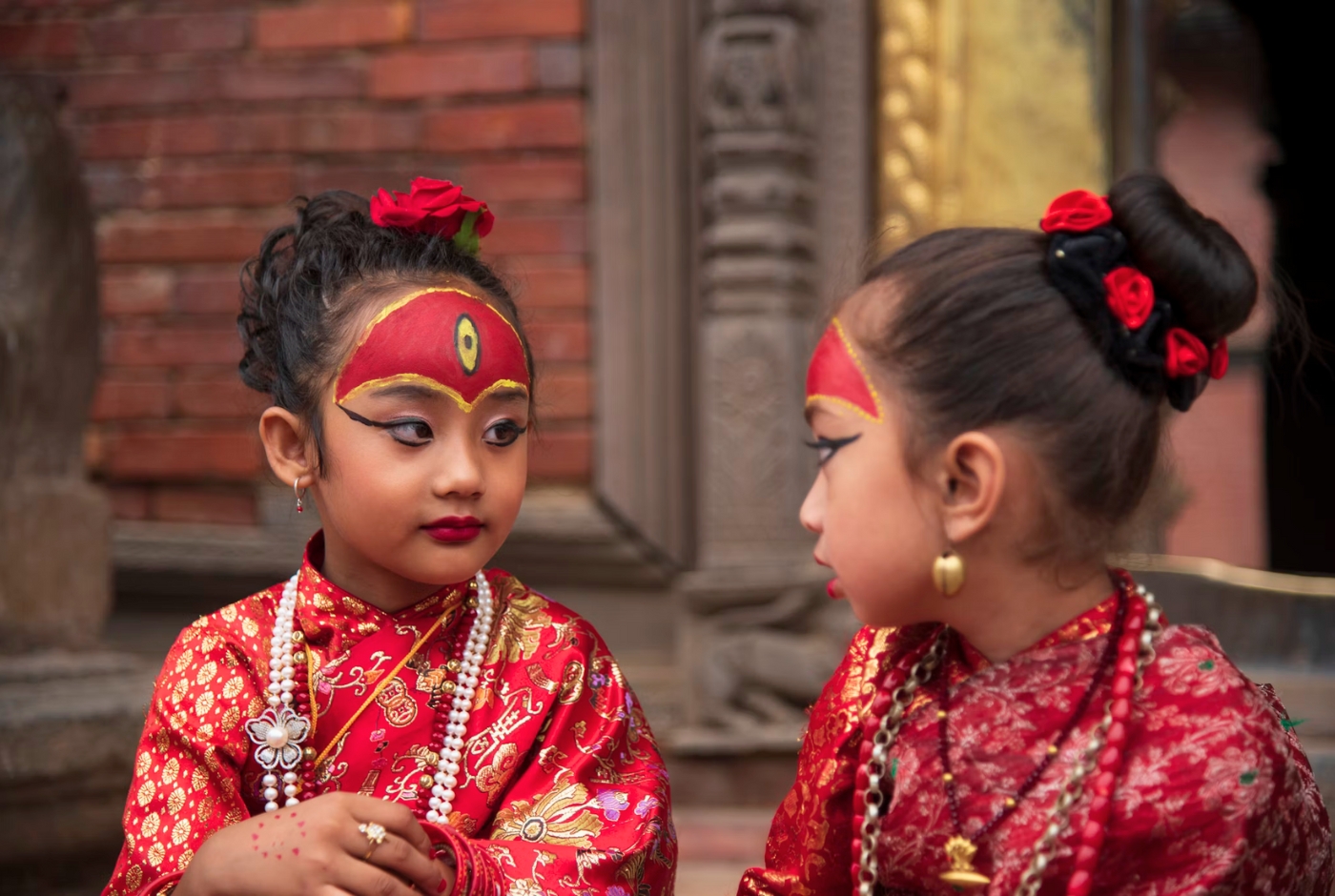
The Procession: A Journey Through Kathmandu
The three days of the Kumari Jatra each have their route and meaning.
Kwaneyā (First Day): On Kwaneyā (the first day), the chariots travel through the city's southern regions, passing through prominent neighborhoods like Lagan Maru and Basantapur.
Thaneyā (Second Day): Second Day or Thaneyā: The procession passes through the northern parts, such as Asan and Indra Chowk, on this day.
Nānichāyā (Third Day): The auspicious third day of Jatra is marked with the chariots of Indra Jatra traveling through the center of the city on the third day of Nānichāyā before returning to Basantapur. The goddess Kumari blesses the locals along the meticulously planned routes; this journey symbolizes the festival's profound spiritual and cultural significance. As the chariots move through the streets, locals gather to witness a stunning demonstration of unity and devotion, infusing the atmosphere with respect and joy. This instance captures the essence of the festival and its treasured customs, fostering unity and happiness among all those in attendance.

Rituals of Remembrance and Reverence
On Kwaneyā, the Mata Biye ceremony takes place at dusk, bringing families together to light butter lamps in memory of loved ones who have passed away in the past year. This heartfelt tribute transforms the city streets into a glowing reminder of grief and the festival's spiritual joy. As the flickering lights brighten the path, a deep sense of connection fills the air, allowing the community to honor those they've lost collectively. It's a touching moment that beautifully blends sorrow and celebration, highlighting the enduring bonds that unite them.
The Dagin and Bau Mata Processions
Following the Kumari's chariot on the first day are two significant processions:
- Dagin: This procession represents Indra's mother as she searches for her son. It features a masked figure that weaves through the city's narrow streets and is accompanied by lively music.
- Bau Mata: This procession showcases a symbolic snake effigy adorned with oil lamps and carried on poles, embodying protection and the cyclical nature of life.
These processions enhance the festival's narrative, blending mythology with active involvement from the community. As residents come together to experience these distinctive displays, the air is enthusiastic and respectful, honoring historical and contemporary significance. This collective participation strengthens bonds and cultivates a spirit of togetherness, highlighting their profound cultural ties.
Cultural Expressions: Dance and Music
During the Jatra, the streets of Kathmandu become lively with the sounds of traditional music and dance, which adds excitement and vitality to the atmosphere. Intricately designed masks and costumes enhance the event's visual appeal as talented actors enact enthralling tales from Buddhist and Hindu traditions. The community's rich cultural heritage is celebrated and preserved thanks largely to these performances, which serve more purposes than just providing entertainment. Every act showcases the richness of the Newar traditions by reflecting their cultural identity and storytelling.
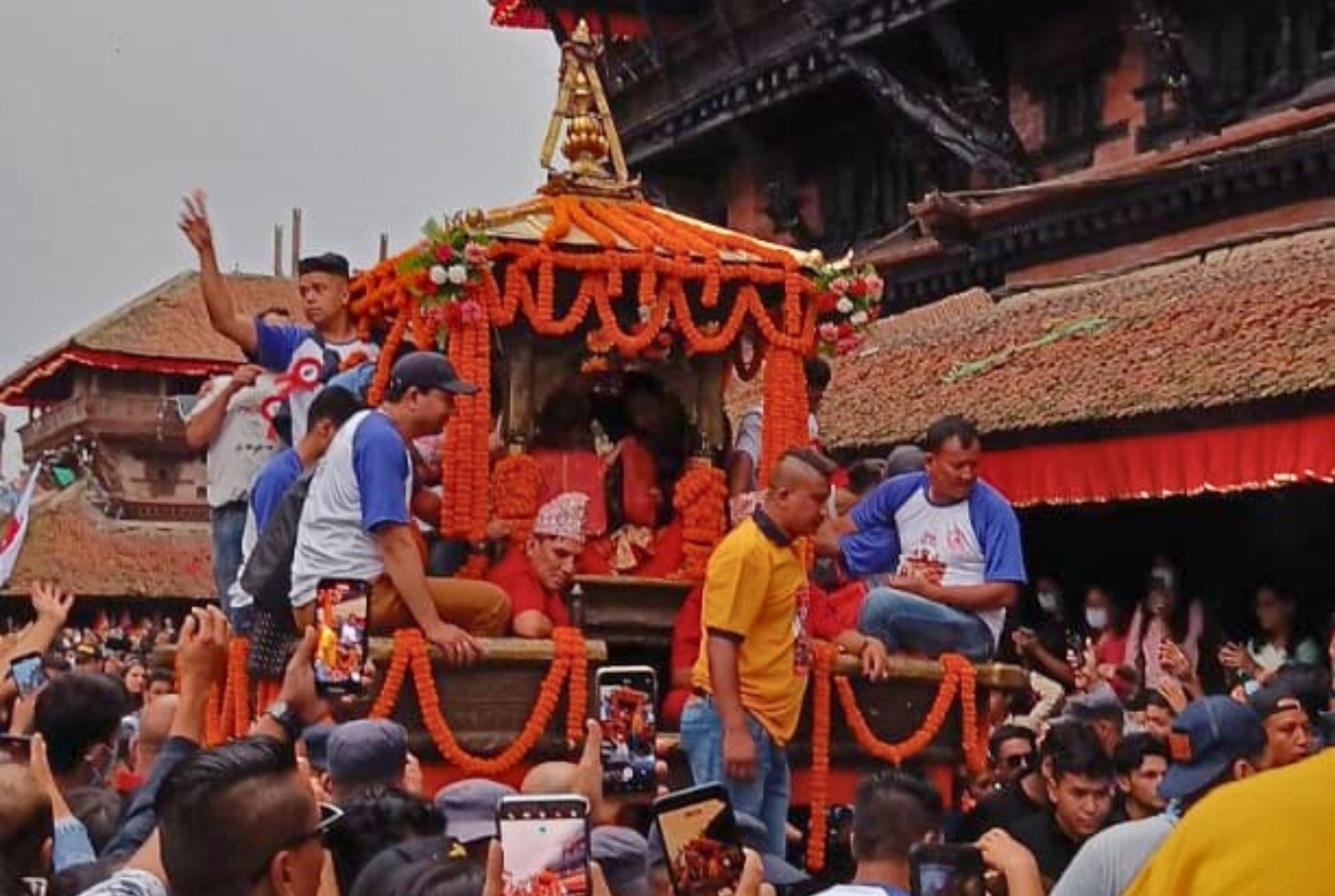
A Living Heritage
The Kumari Jatra represents Kathmandu's vibrant heritage, reflecting its spiritual practices, historical stories, and community connections apart from its spiritual significance. It honors the lasting traditions of the Newar people and serves as an actual affirmation of their identity.
The Exhibitions
Bhairava Masks: Manifestations of Divine Power
Bhairava, the fierce form of Lord Shiva, plays a central role in the spiritual atmosphere of Indra Jatra.
- Sweta Bhairava (White Bhairava): Found at Hanuman Dhoka, this significant mask is hidden throughout the year and revealed only during the festival. It features a pipe that dispenses traditional Nepali alcohol and rice beer, regarded as blessings by worshippers.
- Akash Bhairava (Sky Bhairava): Displayed at Indra Chok, this mask is linked to King Yalambar, the first Kirat king, with legends suggesting his head is enshrined here, representing protection and bravery.
- Bākā Bhairava: Located at Wotu, near Indra Chok, this mask contributes to the diverse representations of Bhairava showcased during the festival.

Indraraj Dyah: Symbol of Devotion
On tall platforms at Maru near Durbar sq. and Indra Chok, there are prominent images of Indraraj Dyah with his hands outstretched and bound by rope. This depiction embodies humility and the close spiritual ties of the community while paying homage to the myth of Lord Indra's capture and release.
Dasavatar Tableau: Celebrating Vishnu's Incarnations
The Dasavatar tableau, which shows the ten incarnations of Lord Vishnu, is performed every evening during Indra Jatra on the steps of the temple in front of the Kumari House. The audience is captivated by the lively depictions of this nightly performance, which combines religious devotion with cultural expression.
Masked Dances
Majipa Lakhey: The Guardian Demon
The Peaceful Bhairava Majipa Lakhey plays a significant role in Indra Jatra. He represents protection from evil spirits by dancing through the streets while sporting wild hair and a striking red mask. His vivacious motions are accompanied by rhyme. A playful aspect of the performance includes a child named Jhyalincha, who humorously interacts with the Lakhey, adding an entertaining element to the display.

Pulu Kisi: The Celestial Elephant
Among the festival's most captivating features is Pulu Kisi, who stands in for Airavata, the fabled elephant of Lord Indra. The story of Indra's quest for his kidnapped self is reenacted through the streets of Kathmandu as this eye-catching white elephant mask is brought to life by animated actors. Pulu Kisi's exuberant antics, which include playful charges and rhythmic tail swings, captivate the audience and represent a delightful fusion of joy and reverence.
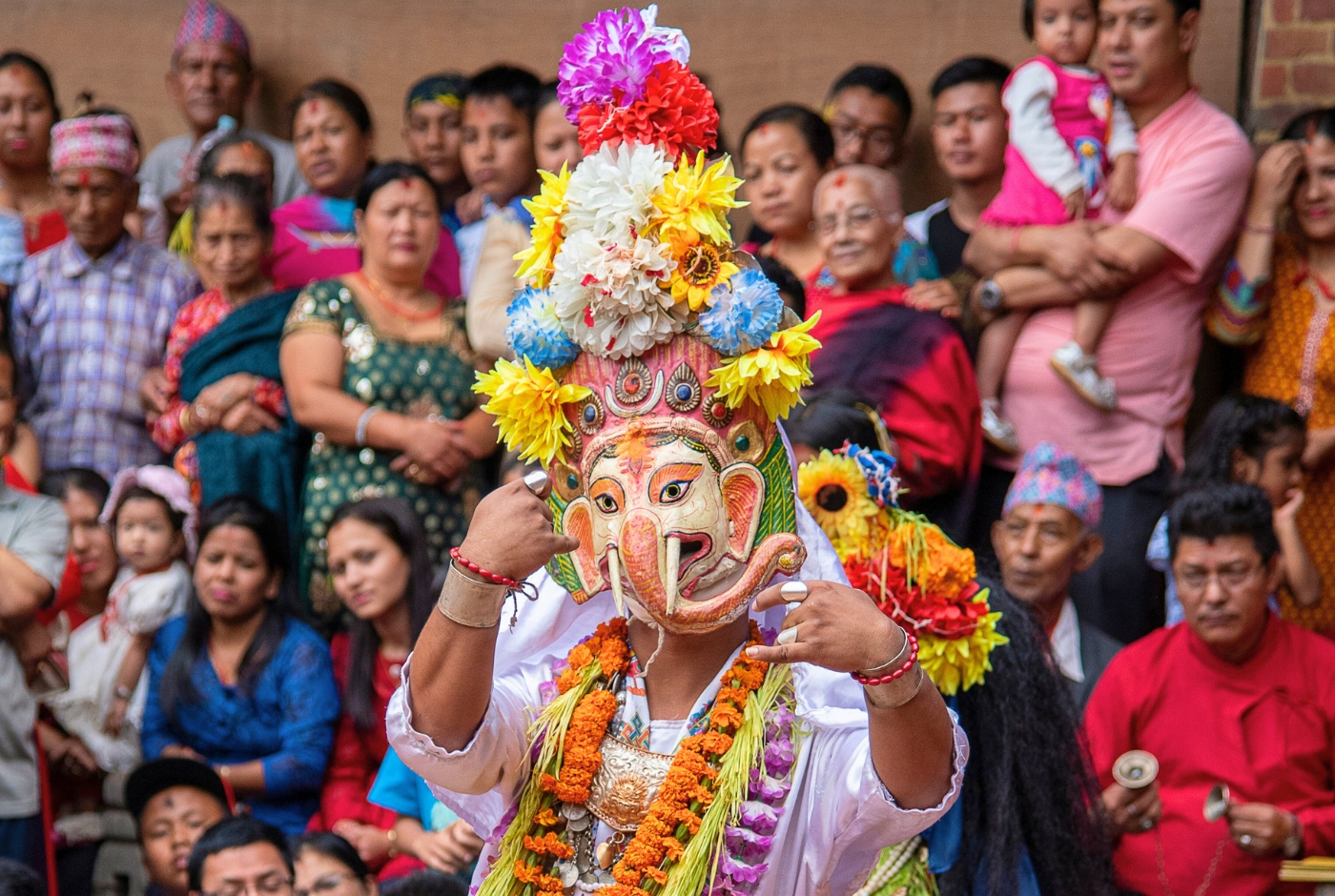
Sawa Bhakku: The Fierce Bhairava
Originally from Halchok, the Sawa Bhakku dance features Bhairava in a bright blue costume wielding a sword and accompanied by two red-clad attendants. Set to stirring music, the dancers' coordinated movements create a mesmerizing ambiance of divine strength that represents the community's protective spirit.
Devi Pyakhan: The Divine Ensemble
Devi Pyakhan is a dramatic dance performance that intricately represents deities such as Chandi and Bhairav Kumari. Using elaborate costumes and masks, performers enact cosmic battles and divine interventions, providing entertainment and a way to convey religious teachings and cultural stories. Additionally, these performances foster a deeper appreciation for the community's rich traditions. They also create an engaging environment where audiences can connect with their spiritual heritage through art and storytelling. The story of Indra Jatra is integral to Kathmandu's cultural and spiritual identity, detailing how Lord Indra, the Hindu rain god and king of the heavens, descended to Earth in search of his mother, Basundhara, and the rare parijat flower.
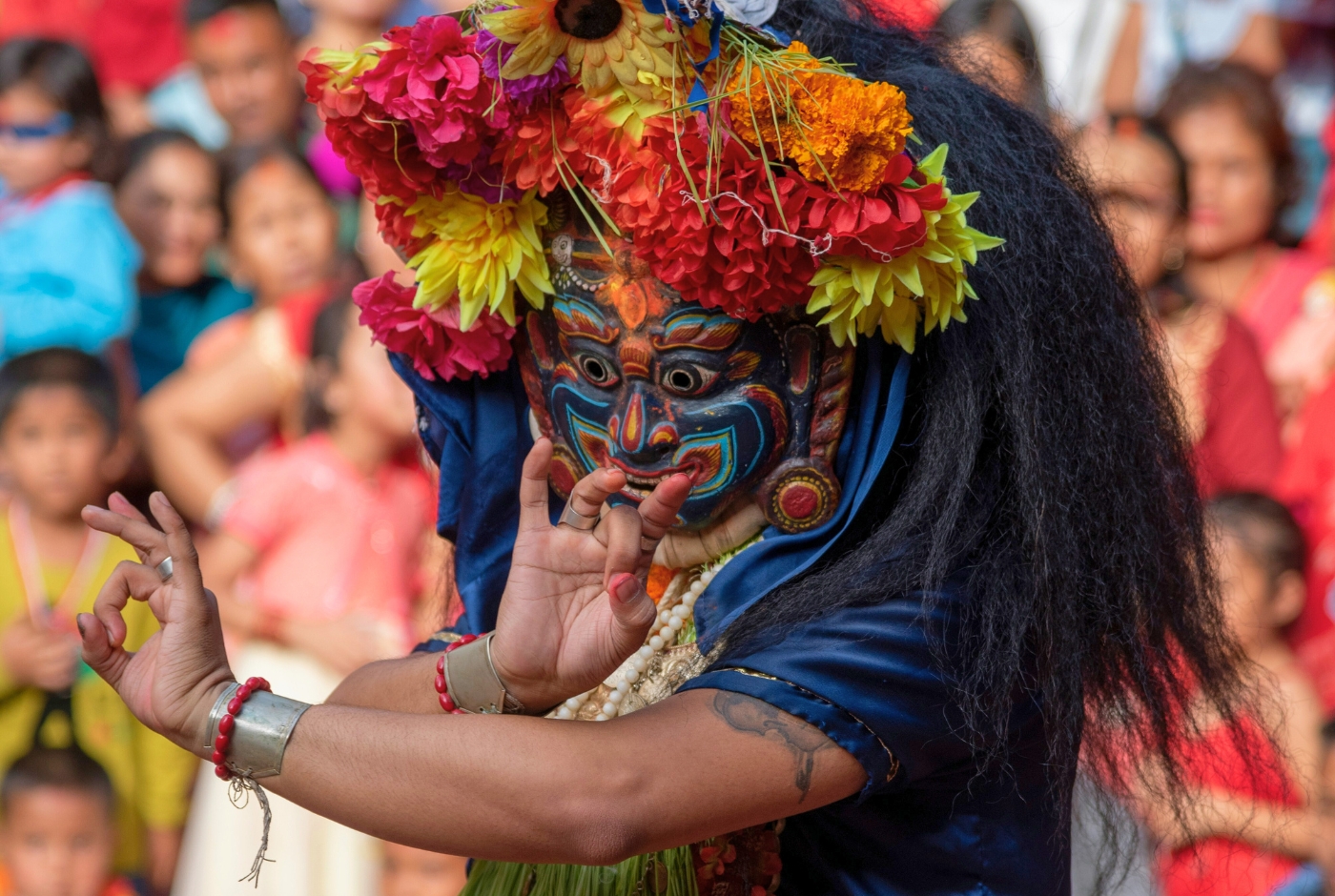
Mahakali Pyakhan: The Dance of Destruction
In ancient times, Lord Indra, the divine king associated with rain, came down from the heavens disguised as a human. His mission was simple yet significant: to collect the parijat flowers his mother, Basundhara, needed for an important ritual. While wandering the streets of Kathmandu, he arrived at Maruhiti, a water spout in Maru. As he picked the flowers, the locals, unaware of his true identity, mistakenly thought he was a thief and captured him. Indra was then tied up and displayed in the town square, drawing a crowd.
The Search: A Mother's Desperation
In the celestial world, Basundhara worried about her son's extended absence. She descended to Kathmandu to search for him, a journey honored by the Dagin procession during the festival. At the same time, Indra's faithful companion, Airavata, the white elephant, roamed the city looking for his master. This frantic search is brought to life through the vibrant Pulu Kisi dance, where performers don a mask representing a white elephant, reenacting the myth.
The Revelation and the Boon
One of the most enchanting aspects of the festival is Pulu Kisi, which symbolizes Airavata, the legendary elephant of Lord Indra. The tale of Indra's quest to rescue his captured self is vividly portrayed on the streets of Kathmandu as lively performers animate this striking white elephant mask. Pulu Kisi's spirited antics engage the audience, featuring playful charges and rhythmic railways, creating a delightful blend of joy and reverence.
Honoring Ancestors: The Spiritual Undertone
Indra Jatra is also a meaningful period for introspection. During the Mata Biye ritual, families illuminate butter lamps along the procession routes to honor their deceased loved ones. This devotion brightens the streets, symbolizing the lasting connection between the living and those who have passed away. Moreover, it serves as a poignant reminder of the love and memories that bind families together. The glow of the lamps creates a serene atmosphere, encouraging participants to reflect on their heritage and the legacies of those who came before them.
Closing Ceremony of Indra Jatra
The closing ceremony of Indra Jatra, referred to as Yosin Kwathalegu, entails the removal and lowering of the Yosin pole, also called the Linga, from Hanuman Dhoka Durbar Square. This marks the conclusion of the festival activities. The pole, which features Indra's flag, is then paraded to the Bagmati River, submerged and broken into pieces to sustain a perpetual light at a different Bhairab temple.

Indra Jatra 2025 Date: When is Indra Jatra Celebrated?
In 2025, Indra Jatra is set to take place on Saturday, September 6, corresponding to 21 Bhadra 2082 in the Nepali calendar. This vibrant festival, deeply embedded in the traditions of the Kathmandu Valley, is recognized as a local public holiday, resulting in the closure of schools and many businesses to celebrate the event.
In 2024, Indra Jatra was observed on Tuesday, September 17, coinciding with 1 Ashwin 2081 in the Nepali calendar.
How do people celebrate Indra Jatra in Kathmandu?
The vibrant eight-day festival, Indra Jatra, which takes place in Kathmandu, has its roots in the customs of the Newar people. The Yosin, a sacred pole representing Lord Indra's presence, is raised to start the celebration.
A significant festival highlight is the chariot procession in which the Living Goddess Kumari and the gods Ganesh and Bhairav enthusiastically pull their chariots through the city's ancient streets. Vibrant masked dances that feature different gods and mythological characters like the Majipa Lakhey and Pulu Kisi are also a part of the celebrations.
Other rites include Mata Biye, where butter lamps are lit in memory of the deceased, and the Dagin procession, which recreates the search of Indra's mother for her son. Devotees participate in unusual rituals such as consuming rice liquor from the deity's mouth to obtain blessings and sacred objects such as Swet Bhairavs masks are displayed.
Indra Jatra pays tribute to Lord Indra, the rain god, and serves as a communal celebration of Kathmandu's rich cultural heritage.

Variety of food served during Indra Jatra
During Indra Jatra, the Newar community partakes in a traditional feast called Samay Baji, which holds cultural and religious significance. This ceremonial platter is carefully prepared and presented to deities, ancestors, and guests, symbolizing gratitude and community unity.
Key Components of Samay Baji
- Chiura (Beaten Rice): A fundamental ingredient that provides texture and serves as the meal's base.
- Chhoyla: Spiced grilled buffalo meat that adds a smoky and flavorful protein element.
- Bhatmas (Roasted Black Soybeans): Crunchy legumes that contribute a nutty flavor and are high in protein.
- Palu (Julienned Ginger): Slices of fresh ginger that enhance digestion and offer a zesty flavor.
- Bara (Lentil Patties): Savory fried cakes made from black lentils may be topped with egg or meat.
- Chatamari: A rice flour crepe, often called 'Nepali pizza,' topped with minced meat and vegetables.
- Saag (Leafy Greens): Sautéed spinach or mustard greens that add a healthy, earthy element to the meal.
- Boiled Egg and Fried Fish: Additional protein options that diversify the platter.
- Achar (Pickles): Spicy and tangy pickled vegetables such as radish and cucumber provide flavor.
- Ayla (Local Rice Liquor): A traditional alcoholic drink complements the meal.

Each of Samay Baji's carefully chosen elements—Earth, water, fire, air, and ether—represents one of the five elements, demonstrating the Newar community's close spiritual ties and connection to nature. In addition to being delicious, this feast is a way to pay tribute to ancestors, show reverence for the gods, and strengthen social ties during the lively Indra Jatra celebrations.
Where to Celebrate Indra Jatra in Nepal?
Indra Jatra is mainly celebrated in the Kathmandu Valley, with the primary festivities in Kathmandu Durbar Square. The celebration also reaches other locations, such as Dhulikhel and Dolakha.
Kathmandu Durbar Square (Basantapur)
The most elaborate celebrations are held in Kathmandu's Basantapur Durbar Square, which serves as the center of Indra Jatra. To start the celebration, a sacred wooden pole known as the Yosin (lingo) is raised before Hanuman Dhoka. The Living Goddess Kumaris' chariot procession, which includes Lord Ganesh and Bhairav chariots, is a major attraction. When masked dances like Majipa Lakhey and Pulu Kisi occur in the streets, devotees swarm to see these age-old customs.
Bhaktapur
The Indra Jatra celebration in Bhaktapur is known as the Indrayani Jatra, during which the idol of Lord Indra's consort, Goddess Indrayani, is paraded around the city. The procession ends peacefully at Siddha Pokhari, where followers perform rites and light butter lamps. A unique aspect of Bhaktapur's celebration is the Mahakali Pyakhan dances, which feature performers dressed in elaborate masks and costumes reenacting mythological stories.
Dhulikhel
Located east of Kathmandu, Dhulikhel observes Indra Jatra with traditional ceremonies and community gatherings. Apart from the smaller celebrations, the locals raise ceremonial poles and hold cultural events to show their devotion and preserve the festival's spirit. As families gather to partake in these treasured traditions, a sense of unity strengthens their ties to their ancestry.
Dolakha
The grand celebration of Indra Jatra in Dolakha is marked by regional customs that mirror the festival's main themes. To preserve this cultural heritage in the region, communities come together to honor Lord Indra through dance, music, and rituals.
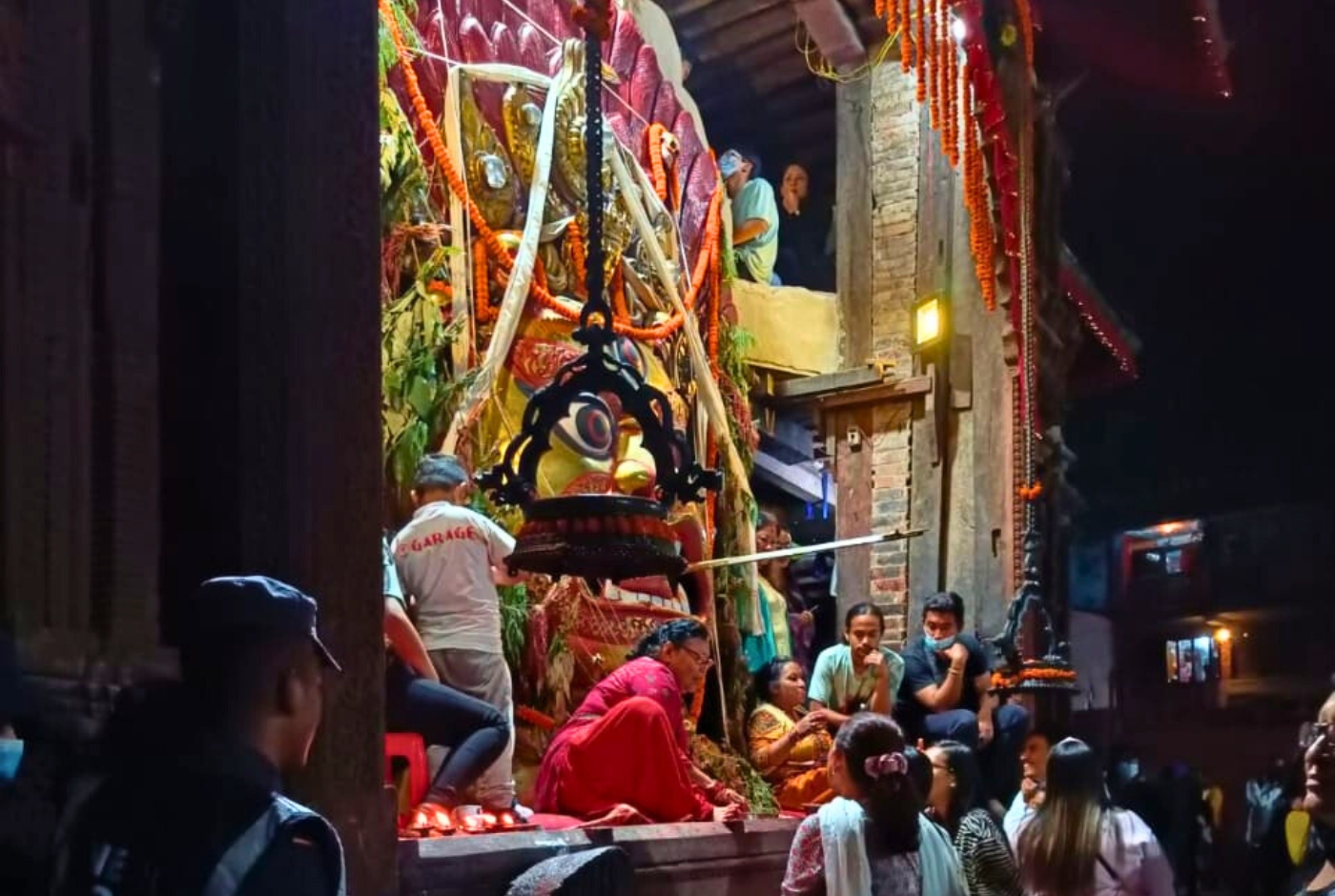
What is the importance of Indra Jatra?
Particularly in the Kathmandu Valley, Indra Jatra is Nepal's significant historical, cultural, and spiritual event.
Agricultural Gratitude: A time for reflection and spiritual rejuvenation. Indra Jatra has agrarian significance. The community can strengthen its bonds with its gods through festival ceremonies and rituals by honoring the divine, reaffirming its beliefs, and asking for blessings.
Spiritual Renewal: Indra Jatra is an agriculturally significant time for introspection and spiritual renewal for Nepalese people. Nepalese people reaffirm their faith by honoring the divine and strengthening their bonds with their gods through festival ceremonies and rituals.
Cultural Preservation: With Nepalese traditional dances, music, and rituals, the festival is a lively celebration of Newar culture. The country's cultural heritage is preserved and passed down through the generations through events like the Kumari Jatra, which features a parade of the Living Goddess on the streets and a variety of masked dances.
Historical Significance: In the tenth century, King Gunakamadeva established the Indra Jatra festival to honor the founding of Kathmandu. This festival has changed, embracing new customs while celebrating the city's rich history. Traditional dances, the display of the Kumari, the living goddess, and the ceremonial raising of the lingo on a ceremonial pole are just a few of the ceremonies that make up Indra Jatra, which originates in Hindu and Buddhist traditions of Nepal. The national cultural festival promotes harmony and camaraderie among Nepalese while paying tribute to the country's past.
Community Unity: The festival promotes a strong sense of community by uniting individuals from different backgrounds in shared rituals and celebrations. This collective involvement strengthens social connections and fosters a common cultural identity.
Does Festival Time Affect My Trekking in Nepal?
Indra Jatra, primarily celebrated in Kathmandu, is unlikely to affect trekking routes outside the valley directly. However, bear the following in mind if your trek starts or ends in Kathmandu during the festival.
- During the festival, road closures and detours may occur in major Kathmandu areas, affecting travel schedules.
- Demand for Accommodations: Scheduling lodging in advance is advised because increasing tourists may lead to a greater demand for hotels and guesthouses.
- Transportation Availability: Domestic flights and public transport will probably be busier than usual.
For a fantastic trip, purchasing your tickets in advance is advisable to prevent delays.
Conclusion
Save the date, September 6, 2025, in Kathmandu for this vibrant Indra Jatra celebration, where you can learn about Nepal's rich customs and culture. Enjoy vibrant processions, traditional music, and delicious local cuisine as the city bursts with life during this festive occasion. Once you've experienced the excitement of the festival, set off on an incredible trekking journey to either Everest Base Camp (EBC) or Annapurna Circuit Trek with the reputable Nepal Hiking Team. When booking with the Nepal Hiking Team, you are on a fantastic trip in Nepal full of breathtaking scenery, friendly people, and lifelong memories, regardless of whether you choose Everest's majestic views or Annapurna's stunning landscapes. Take advantage of this excellent opportunity to blend cultural exploration with an exhilarating trekking journey. This timing aligns perfectly with the onset of Nepal's autumn trekking season, providing clear skies and ideal conditions for your journey. The autumn trekking season begins following the festival, characterized by stable weather and clear skies. The best periods for trekking to EBC are from mid-September to November and for ABC, from late September to November.
Join us for an unbeatable journey in the Himalayan region with our premier travel agency, the Nepal Hiking Team provides the best customized tour packages to experience diverse destinations, personalized itineraries, attractive pricing, outstanding value, immersive cultural experiences, and expert guidance; we guarantee your journey will be truly memorable. Join our countless satisfied travelers and let us turn your travel dreams into reality. Contact us today to start your adventure!


